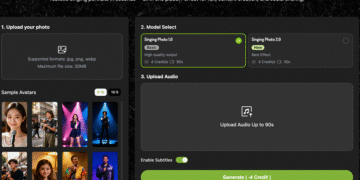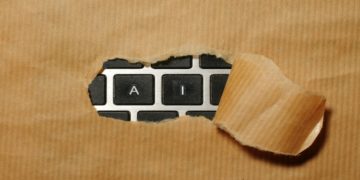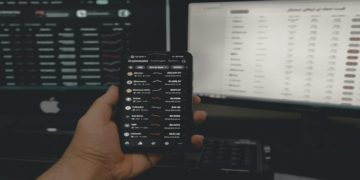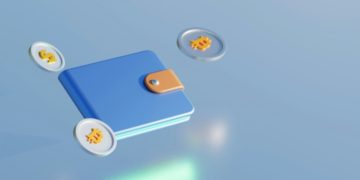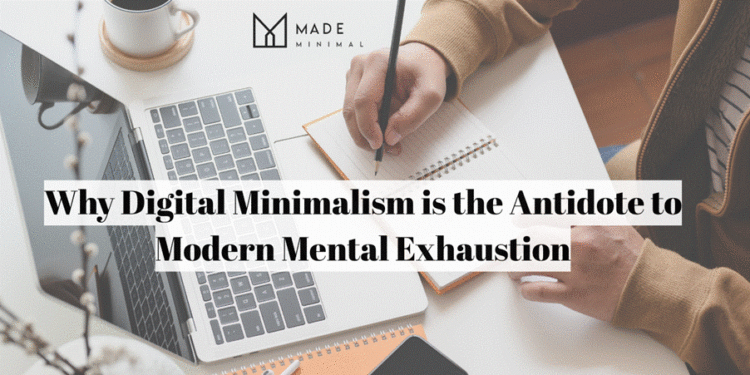Your phone chimes with another notification. You check it, then find yourself scrolling for twenty minutes. Sound familiar?
Digital clutter affects your mind just like physical clutter affects your home. The constant pings, endless apps, and overflowing email inboxes create the same overwhelm you feel in a messy room.
After years of helping Australians create calmer, more intentional living spaces at MadeMinimal, we’ve learned that true minimalism extends beyond furniture and decor. Your digital life also needs the same thoughtful approach.
In this article, we’ll show you how to:
- Understand digital minimalism and how it protects your mental health
- Try a 30-day digital declutter to reset your relationship with screens
- Delete apps and create screen-free environments in your home
- Reduce anxiety and build stronger real-world connections
Stick with us as we walk you through the steps to change your relationship with technology and create the focused, peaceful life you deserve.
What is Digital Minimalism, and How Does it Save You from Mental Burnout?
Digital minimalism means being intentional about technology by setting clear boundaries with devices, choosing quality content and creating tech-free zones in your daily routine. You keep what serves you and declutter what doesn’t.
Think about those moments when you pick up your phone to check one thing, and suddenly you’re deep in a scroll hole. You never meant to spend thirty minutes watching random videos, but here you are. After a few days of mindless scrolling, you’ll find yourself emotionally exhausted even though you haven’t done anything productive.
Even more concerning is what science tells us about this tech habit. Research from the Adolescent Brain Cognitive Development Study shows that higher screen time creates measurable changes in mental health, with the strongest links to depressive symptoms. The study followed 9,538 children and found that each additional hour of screen time creates:
- Increased depression symptoms
- Higher anxiety levels
- Poor sleep quality
- Reduced attention span
But when you become a digital minimalist, you protect your mental health while still enjoying the genuine benefits of our connected world. The benefits show up fast once you make the switch. People who practice digital minimalism report better focus, improved sleep quality and stronger real-world relationships.
Once you understand why digital minimalism works, the next step is putting it into practice with a proper detox plan. The best part about digital detoxing is that you don’t need to throw your phone in a drawer and go completely offline to see results.
Practical Steps for a Digital Detox
Now that you have a clear understanding of why digital minimalism works, it’s time to put these ideas into action.

A digital detox means taking a break from non-essential technology to reset your relationship with screens and reclaim your mental space. The process works more simply than most people expect, and you can do it gradually without turning your life upside down.
Here are three simple approaches that will help you start your digital detox journey:
The 30-Day Digital Declutter
A thirty-day digital declutter is a clean break for a month from non-essential digital devices and social media apps from your daily routine. So you reconnect with the offline world and focus on the present moment without constant digital distractions.
During this period, you’ll discover activities that add value to you while your mind adjusts to life without endless scrolling. Many people report increased focus and better sleep quality after just one week. The reason this works so well is that your brain gets a chance to reset its attention patterns.
Though you can set a time limit for essential apps like email or maps, what counts is eliminating anything that pulls you away from real-world experiences.
Helpful Tip: Start with just your phone rather than all digital devices at once. This makes the process less overwhelming and easier to stick with long-term.
Deleting Apps and Unsubscribing
When you delete time-wasting apps from your digital devices, you remove the temptation to mindlessly scroll through your day. This becomes the first practical step in your journey toward a focused life. You don’t need to unplug completely, but removing apps that drain your attention gives you more energy for activities that add value to your life.
The process is simple but powerful. For instance, you can delete social media apps, unsubscribe from email lists that don’t serve you and remove games that eat up hours of your time. Finally, you’ll find you have time for those sketchbooks and novels sitting on your shelf for months.
How to Create a Screen-Free Environment
To create a screen-free environment, you need to designate specific areas in your home where digital devices aren’t allowed. This helps you build stronger connections with real conversations and genuine moments because people naturally engage more when screens aren’t competing for attention.

We suggest trying to avoid your phone first thing in the morning to start your day calmly. Instead of reaching for your device, try stretching or making your bed first. Your phone will still be there after you’ve had a proper wake-up routine, but your morning peace won’t be.
Since you know how to create these boundaries, what comes after is understanding what long-term benefits await you. You’ll discover that focused living becomes more natural as these habits take root in your daily routine.
The Long-Term Benefits of Focused Living
The long-term benefits of focused living give you improved mental clarity, deeper relationships and a genuine sense of calm that comes from being present in your own life. These changes don’t happen overnight, but they build momentum as your new habits take hold.
Over time, you’ll see how these benefits compound and create a foundation for ongoing wellbeing and authentic connection.
Here’s what you can expect when you commit to this way of living:
Reducing Anxiety with Digital Minimalism
What if we tell you that your constant sense of worry and restlessness can be reduced simply by changing how you interact with technology? Yes, you heard it right. Digital minimalism naturally lowers anxiety levels because your mind isn’t constantly processing notifications and updates.
When you focus on one task at a time instead of juggling multiple apps and alerts, your nervous system gets the chance to settle. Even a simple meditation app works more effectively when social media isn’t competing for your attention.
One of our clients shared his story with us about how reducing screen time helped him sleep through the night for the first time in years. He discovered that his evening phone habits were keeping his mind racing long after he went to bed. But within two weeks of putting his phone in another room at night, his sleep quality improved dramatically. Isn’t that something worth trying?
Building Real-World Connections
In our increasingly noisy world, people crave genuine connection as it becomes harder to find authentic moments together. You’ve probably noticed that too when you’re sitting with someone who keeps checking their phone during your conversation.
However, when you put your device aside and give someone your complete focus, the conversation shifts to a deeper level. The reason this works is that undivided attention has become so rare that it feels like a gift when someone offers it.
Helpful Tip: Consolidate texting to specific times of day, and you create space for deeper conversations that strengthen your relationships.
What’s more interesting is how quickly people respond to your full attention. You’ll notice that friends and family members put their phones away too when you model this behaviour, creating a ripple effect of meaningful connection throughout your social circle.
Breaking Free from Screen Addiction
Sometimes digital overwhelm becomes your default daily experience without you noticing the gradual shift. The constant ping of notifications and endless scroll sessions hampers your mental clarity and genuine happiness. But when you choose digital minimalism, you break free from technology’s grip on your attention.
In this article, we’ve covered practical detox methods and the long-term benefits of reducing screen dependence for better mental health. The solution requires intention but delivers freedom from the anxiety that constant connectivity creates.
This is the best time to step away from digital overwhelm and step into intentional living. If you need any help making this transition, our team will be here to provide guidance and support.




